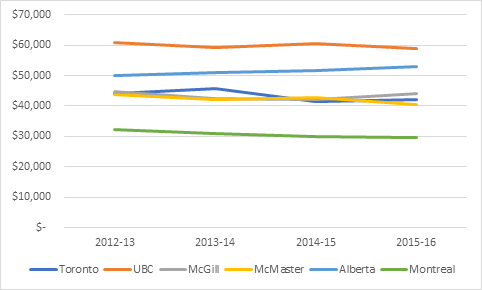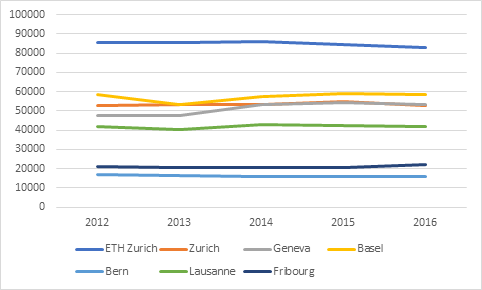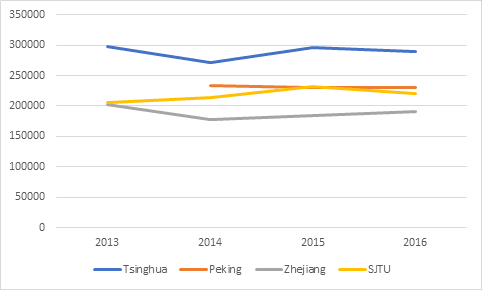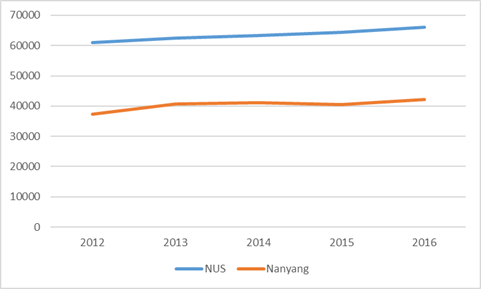The other day, I questioned a claim made by University of Toronto President Meric Gerlter that we were falling behind countries like “China, Switzerland and Singapore” having made major recent investments in science and higher education. First of all, I noted, this was an odd trio, with nothing much to suggest it was true other than the rise of a few institutions in such countries as doing reasonably well in various university rankings. Second, I noted that the claim that we are “falling behind” these countries was factually untrue, at least as it relates to investments in higher education. Today, I’m going to prove that, by comparing recent data on expenditures in top universities in each of these to expenditures in ours.
(To be clear before I press on: I’m singling out Gertler for criticism because the Star picked up on his comment. But he’s far from the only one to have made it – I’ve heard that same line a couple of times lately in Canadian PSE. So think of today’s column as a general warning shot on the topic of international comparisons rather than me taking down anyone in particular).
So let’s look at what’s been happening in each of these countries over the past few years, using data obtained from each institution’s annual & financial reports. Let’s start with Canada. Real expenditures per student at top universities rose in the latter half of the aughts and early in this decade. Since 2012, they have been mixed, rising slightly at Alberta (+6%) and falling slightly at McGill (-2%), UBC (-3%) and Toronto (-4%) and more sharply at McMaster and Montreal (-8%). Summed across all institutions, it’s a drop of 4%.
Figure 1 – Per-student Expenditures of Top Canadian Universities, 2012-13 to 2015-16 (in C$2016)
Now let’s take a look at those other countries over the same period. Let’s start with Switzerland, where we will look at the seven universities that make the Shanghai top 200. Has there been an increase in expenditures? Yes, there has: about 5.6% over the last few years. But that’s been almost exactly matched by a 5% increase in students. Interestingly, the growth in student numbers has been most pronounced at the best university: ETH Zurich – the institution to which the University of Toronto would be likeliest to compare itself – has seen it’s funding per student fall by 3% as a result. Most of the per-student gain comes at the one university – Geneva – which saw a significant fall in student numbers.
Figure 2 – Per-student Expenditures of Top Swiss Universities, 2012 to 2016 (in SFr 2016)
Let’s move over to China. Data from China is not great (as I noted a couple of weeks ago, Chinese universities are getting more transparent about institutional finances, but getting accurate institutional enrolment numbers is practically impossible). Still, to the extent we have information, what we see is essentially no change over the past four years – up slightly at Shanghai Jiao Tong, down slightly everywhere else.
Figure 3 – Per-student Expenditures of Top Chinese Universities, 2013 to 2016 (in RMB 2016)
I know that one seems hard to believe given all we hear about “massive Chinese investments” in higher education. And in the previous decade: say from 2000 to 2010, it’s true that there were massive investments. But lately, expenditures are not quite keeping up with inflation and growth in student numbers.
(Some people may point to forthcoming investments on the back of China’s recently announced and then re-announced “Double World-Class” program, as per this recent article in Caixin Global. But the amounts being bandied about here don’t actually seem all that significant. Sun-Yat Sen University, for instance, is breathlessly reported as being in line to receive an extra RMB 480 million as part of this project. But on a budget of over RMB 6 Billion, that’s less than an 8% increase, which given inflation and student growth probably washes out in less than two years. So treat these claims with skepticism)
Finally, we have Singapore, where we do see clear-cut growth in real expenditures per student over the last few years, at the National University of Singapore (8%) and Nanyang University (13%).
Figure 4 – Per-student Expenditures of Top Singaporean Universities, 2013 to 2016 (in S$2016)
So, does this back up Gertler’s “greater investment” claims? No, not quite. A closer look at the two institutions financials shows something more subtle. In both cases, universities started spending more relative to their income: Singapore went from posting a 5% surplus to a 1.5% surplus between 2012 and 2016; in Nanyang’s case, the institution went from about a 5% surplus to a 3% deficit, which implies in both cases it was changes in financial habits as much as any new investment doing the work. And some of the work was done by increased tuition fee income. The increase in research income from government sources is really only doing about a third of the work here.
So, are China, Switzerland and Singapore really “leaving Canada behind”? In the case of China and Switzerland the answer seems to be: only marginally, if at all. In Singapore – tiny Singapore – the evidence that more money for research in play is clearer, but the total “extra funding” in question is maybe $250 million at two universities who between them might have 4,000 tenured faculty.
If this is the best competition we have, I’d say we’re doing OK.





 Tweet this post
Tweet this post
